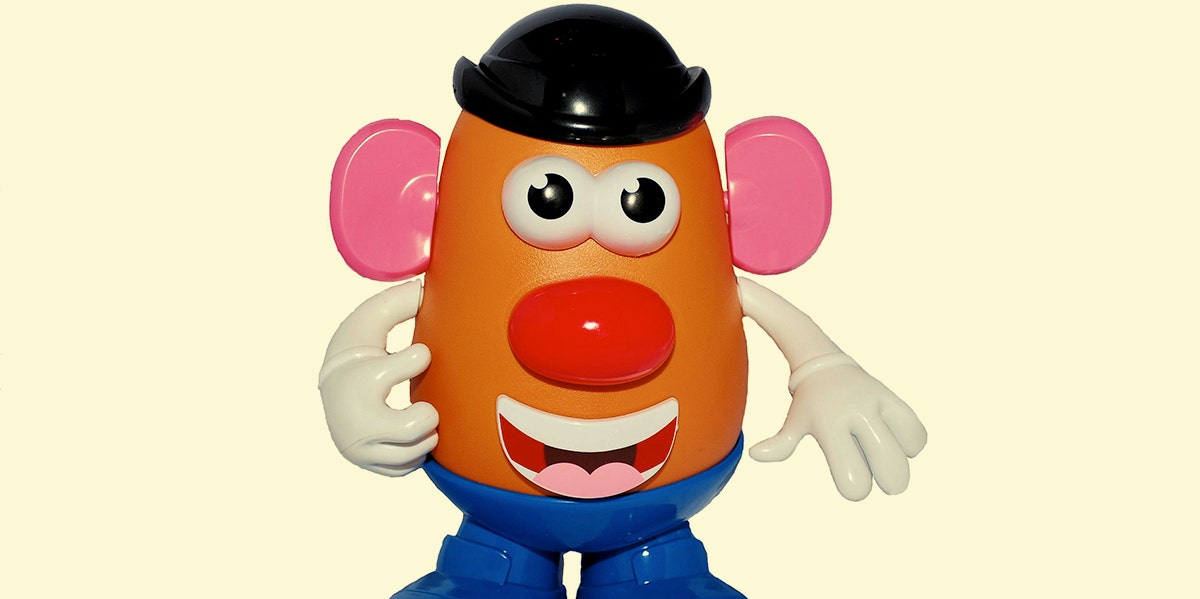Hasbro Introduces Gender-Neutral Version Of Iconic 'Mr. Potato Head' Toy
Hooray for gender inclusivity!
 Julie Clopper / Shutterstock
Julie Clopper / Shutterstock After almost 70 years, the iconic Mr. Potato Head toy is getting a 21st century rebranding.
The “Mr.” from the name is being dropped as well as “Mrs.” and although this may seem like a minimal change and not much difference, it goes beyond traditional views, and serves to break away from traditional gender norms.
When it comes to Potato Head families, it will change how children used to traditionally play with these toys.
The new brand is set to unveil in fall of 2021 and when it does, kids will have a blank Potato head to create same-sex families or single-parent families.
This change shows how society today is affecting toy brands and how they are adapting to stay relevant.
Mr. Potato Head was launched by Hasbro in 1952 for the price of $0.98, which would be about $10 today. The following year, they released Mrs. Potato Head with female accessories such as hair bows and red heels.
Back then, however, families would have to use real potatoes to put the accessories on. The accessory pieces included hands, feet, and eyes, and pieces of felt meant to be used as mustaches.
The large success of Mr. Potato Head can be credited to the fact that it was the first toy to be marketed directly to children. It clearly worked, as they sold more than one million in the first year.
Kimberly Boyd, the SVP and GM at Hasbro that works on the Potato Head brand, said the success of the toy comes down to the “silliness” of the toy.
“The sweet spot for the toy is two to three years old,” Boyd said. “Kids like dressing up the toy, then playing out scenarios from their life. This often takes the form of creating little potato families, because they’re learning what it means to be in a family.”
In 2012, Hasbro released a boxed set featuring the potato couple to celebrate their 60th wedding anniversary.
Over the years, the brand has played heavily into the idea of creating families. From selling Mr. and Mrs. Potato Head along with small potato children.
Today, however, the brand wants to stop leaning so far into the structure of a traditional family.
“Culture has evolved,” Boyd said. “Kids want to be able to represent their own experiences. The way the brand currently exists—with the “Mr.” and “Mrs.”—is limiting when it comes to both gender identity and family structure.”
Upon the release of the news on Thursday, Hasbro faced lots of backlash from its customers and consumers alike who don’t agree with the change.
“Honestly, it’s your weakness and virtue signaling that offends me. Pick one and stick to it - if you want to play woke so you can cater to the masses don’t backtrack as soon as you sense an ounce of backlash,” one Twitter user wrote.
Some social media users were conflicted by the change and fell on both sides of the backlash.
“i love this on an objective level because i strongly believe in the abolishment of gender roles and bigotry but i also kinda don't like it because i grew up with the icon known as mr potato head,” another Twitter user wrote.
They took to Twitter to clarify that they would continue to sell Mr. and Mrs. Potato Head toys, but that the family sets would be gender-neutral to promote inclusivity.
This was verified in the images they posted where it shows two dads and two moms, as well as a heterosexual couple on the packaging of the box.
The brand’s goal is to drop the title differentiated by gender altogether.
This allows children the freedom of expression and to make the Potato Heads look exactly what they think they should look like. If they want a boy potato to wear a bow and use a purse then they should be allowed to.
This allows children to also project their own views and ideas about gender, sexuality, and family onto the toy.
Other toy brands, like Mattel, have worked to push the boundaries as well. It might be a bit harder for them, though, as the storylines around Barbie and American Girl usually involve marriage between a boy and a girl.
Same with Disney — princesses tend to marry princes or don’t get married at all.
Although many are rejecting the change from Hasbro, change can sometimes be good.
There are little boys and girls out there growing up now being able to relate to certain toys who dress in ways that they don’t like or agree with.
Hasbro’s decision to drop the “Mr.” and “Mrs.” allows children all around the country to feel more included and to be able to express their freedom on how they think the toys should dress and look like
Hasbro has taken a big step towards breaking away from traditional gender norms and will allow children to dress their toys the way couples should look.
Tomás Diniz Santos is a writer living in Orlando, Florida. He covers news, entertainment, and pop-culture topics.

